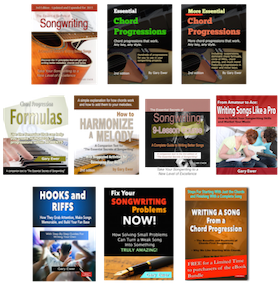You’re working out the melody for your next tune, but the chords just aren’t happening? Here’s a basic set-by-step for harmonizing a melody.
____________
Download “The Essential Secrets of Songwriting” eBook Bundle, and increase your song’s HIT potential.
_____________
 It doesn’t matter how good your melody is if your chord progression doesn’t work. A chord progression is like the piece of land you build your house on. It doesn’t matter how good the house is if you’ve built it on a lousy piece of swampy land that can’t support the foundation. You want that land to be interesting, but even more important than that is the support it gives. So how do you make sure that the chords you choose will provide the right harmonic support for your melody? How can you be certain that your melody is being properly supported?
It doesn’t matter how good your melody is if your chord progression doesn’t work. A chord progression is like the piece of land you build your house on. It doesn’t matter how good the house is if you’ve built it on a lousy piece of swampy land that can’t support the foundation. You want that land to be interesting, but even more important than that is the support it gives. So how do you make sure that the chords you choose will provide the right harmonic support for your melody? How can you be certain that your melody is being properly supported?
 Chords and melodies are actually just two aspects that work hand in hand during the songwriting process; the other is the lyric. But lets deal with chords and melodies for now. If the chords don’t work properly, you’ll find that even fantastic melodies become ineffective as the bad chords will distract listeners.
Chords and melodies are actually just two aspects that work hand in hand during the songwriting process; the other is the lyric. But lets deal with chords and melodies for now. If the chords don’t work properly, you’ll find that even fantastic melodies become ineffective as the bad chords will distract listeners.
Most pop songs are a short 4-5 minute musical journey. Like any journey, both real and metaphorical, we need a location that serves as both a starting and ending point. In other words, a trip usually starts and ends at the same spot.
Some song genres might allow for a more abstract kind of approach with melodies and harmonies. But if you’re looking to write the kind of song that becomes popular rather quickly with the largest cross-section of the public, the tonic note and chord is that all-important location.
The tonic note, and the chord that is built upon it, is the note represented by the key of your song. A song in A major has a tonic note and chord of A.
Here are some basic pointers for adding chords to your melodies.
- Make sure your chorus melody gives prominence to the tonic note and chord, especially at the end of the chorus.
- You’ll often find that verse melodies work well if they move toward the dominant note (i.e., the 5th note of your chosen key), or some other non-tonic note. When verse melodies end on a note other than the tonic, the audience wants to hear the tonic note happen soon, and it helps generate song energy.
- If your song is in a major key, your verse melody should start on a note from the tonic chord. If your song is in A major, good starting notes are C# or E. (You don’t as often see the tonic note as a starting pitch.)
- Strong progressions usually involve chords that are a 4th or 5th away from the next one – the so-called “circle-of-fifths.” So to create the strongest progressions you can for your melody, try to accompany it with chords that feature the circle-of-fifths. (For example: E-A, Bm-E-A, F#m-Bm-E-A, and so on.)
- Identify the strong beats in your melody, and choose chords that contain those notes. As you know, you can’t (and definitely shouldn’t) harmonize each and every note of a melody. So which ones do you harmonize? Sing your melody through, tapping your foot, and try to identify the strongest beats. Usually it’s every 2 beats, or every 4 beats. The note that you harmonize should exist in the chord you choose. Then make sure, at least much of the time, that the chord you choose to follow that one is a “strong” choice – one that really emphasizes the key you’re in. As mentioned, the circle-of-fifths is a very common progression, and you’ll see it in hit pop songs more often than almost any other choice.
____________
 PURCHASE and DOWNLOAD the songwriting e-books for your laptop/desktop
PURCHASE and DOWNLOAD the songwriting e-books for your laptop/desktop










 Written by Gary Ewer, from “The Essential Secrets of Songwriting” website.
Written by Gary Ewer, from “The Essential Secrets of Songwriting” website.